Karl Albert Buehr stands as a significant, if sometimes underappreciated, figure in the narrative of American Impressionism. A German émigré who found his artistic voice in the burgeoning cultural landscape of Chicago and later immersed himself in the heart of Impressionism in Giverny, France, Buehr’s career is a fascinating study of transatlantic artistic exchange and personal stylistic evolution. His legacy is marked by luminous canvases, a dedication to teaching that shaped a generation of artists, and a steadfast commitment to capturing the fleeting beauty of light and life.
Early Life and Transatlantic Beginnings
Karl Albert Buehr was born in Feuerbach, near Stuttgart, Germany, in 1866. He was one of seven children in a family that, by some accounts, enjoyed a degree of prosperity. The late 19th century was a period of significant migration from Europe to the United States, driven by economic opportunity and social change. In 1869, when Karl was merely three years old, the Buehr family embarked on this transformative journey, immigrating to the United States and settling in Chicago, Illinois.
Chicago at this time was a rapidly expanding city, a hub of industry and commerce, still recovering from and rebuilding after the Great Chicago Fire of 1871, which occurred shortly after the Buehrs' arrival. This environment, one of dynamic growth and resilience, would form the backdrop of Buehr's formative years. While details of his early childhood in Chicago are not extensively documented, it is clear that the city's burgeoning artistic institutions would eventually play a crucial role in his development.
Artistic Awakening at the Art Institute of Chicago
Buehr's formal artistic training began in earnest when he enrolled in night classes at the Art Institute of Chicago in 1888. The Art Institute, founded as the Chicago Academy of Design in 1866 and re-established under its current name in 1882, was quickly becoming one of the premier art schools and museums in the United States. For a young man with artistic aspirations, it was the natural place to gravitate.
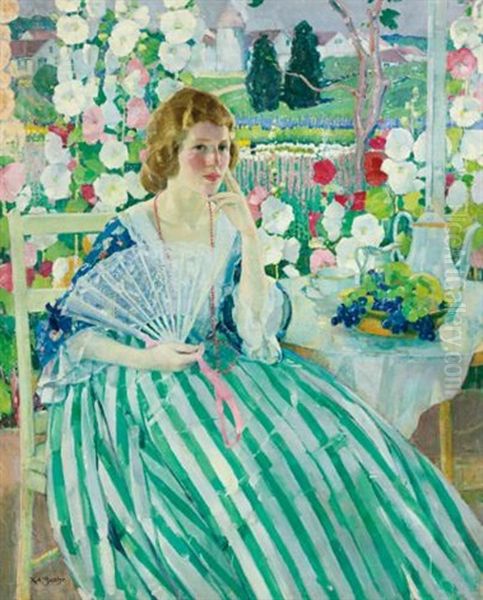
During his student years, Buehr reportedly worked at a lithography company. One anecdote suggests he also took a position as a night watchman at the Art Institute itself. This role, serendipitously, offered him unparalleled access to the museum's collection. It is said that he used these quiet hours to study and sketch the works of established masters, an informal education that undoubtedly supplemented his formal instruction. This period of intense study and practice laid a strong foundation in academic drawing and painting. He was a diligent student, and his talent did not go unnoticed. By the time he graduated with honors in 1897, he was recognized as one of the Art Institute's most promising talents. An early review in the Chicago Times-Herald in 1896, commenting on a student exhibition, praised his work as "joyous and vibrant," indicating an early inclination towards a lively palette and expressive handling.
European Sojourn: Paris, London, and the Lure of Impressionism
Following his graduation and a brief period that included service in the Spanish-American War in 1899, Buehr, like many ambitious American artists of his generation, felt the pull of Europe. Paris, then the undisputed capital of the art world, was the primary destination. He traveled to Europe around 1899-1900, seeking to further refine his skills and immerse himself in the continent's rich artistic traditions and contemporary movements.
In Paris, he is known to have exhibited at Auguste Dufourcoulon's gallery. He also sought instruction from respected academic painters. While specific names of his Parisian tutors vary slightly across sources, figures like the academic painter Jean-Léon Gérôme, or artists associated with the Académie Julian such as Tony Robert-Fleury or William-Adolphe Bouguereau, represented the kind of rigorous training many sought. He also studied at the London Art School. This period would have exposed him not only to the established academic tradition but also to the revolutionary waves of Impressionism and Post-Impressionism that had reshaped European art. Artists like Claude Monet, Pierre-Auguste Renoir, Edgar Degas, and Camille Pissarro had already established Impressionism, and the Post-Impressionist explorations of Vincent van Gogh, Paul Gauguin, and Paul Cézanne were gaining traction.
The Giverny Years: Immersion in Impressionism
A pivotal chapter in Buehr's artistic development began in 1901 when he settled in Giverny, the small French village that Claude Monet had made famous. Giverny had become an international artists' colony, attracting painters from America and beyond, all eager to be near the master of Impressionism and to paint the picturesque Normandy landscape. Here, Buehr joined a vibrant community of American artists.
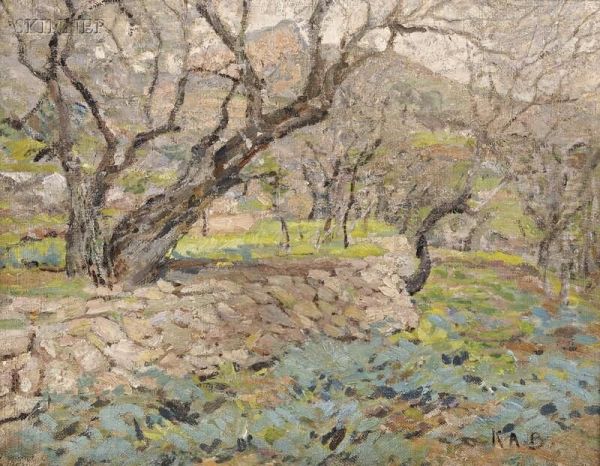
Crucially, Buehr developed a friendship and working relationship with Frederick Carl Frieseke, another prominent American Impressionist who became a leading figure in the Giverny art colony. Frieseke, known for his depictions of women in sun-dappled interiors and gardens, shared Buehr's interest in light and color. They often painted together, sharing insights and undoubtedly influencing each other's work. Buehr also became a friend and colleague of Monet himself. While Monet was an iconic and somewhat reclusive figure, he did interact with some of the younger artists who flocked to Giverny. The proximity to Monet and the daily practice of plein air painting in the Impressionist Mecca profoundly shaped Buehr's style.
Other American artists who were part of the Giverny colony around this time or were significantly influenced by its ethos included Theodore Robinson (an early American Impressionist who was close to Monet), Willard Metcalf, Lilla Cabot Perry (who also had a close relationship with Monet), Guy Rose, and Richard E. Miller. Buehr's time in Giverny, which extended over several years with intermittent returns to Chicago, was instrumental in his adoption of a high-keyed palette, broken brushwork, and a focus on capturing the transient effects of light and atmosphere – the hallmarks of Impressionism.
Return to Chicago and a Distinguished Teaching Career
Although Buehr spent significant periods in France, particularly in Giverny, he maintained strong ties to Chicago. He returned to the city periodically and, by 1914, had re-established himself there more permanently, partly due to the outbreak of World War I making extended stays in Europe difficult. Upon his return, he was appointed as an instructor at the Art Institute of Chicago, the very institution where he had received his foundational training.
Buehr became a highly respected and influential teacher at the Art Institute, a position he held for many years, continuing to teach well into his later life. His direct experience with French Impressionism and his personal acquaintance with figures like Monet and Frieseke lent considerable authority to his teaching. He was able to impart not just the techniques of Impressionism but also its spirit and aesthetic principles to a new generation of American artists. Among his notable students were William S. Schwartz, who became known for his modernist and symbolist works, and Christian von Schneidau, a portrait and landscape painter. His impact extended to many others who passed through the Art Institute's classrooms, contributing to the Midwest's evolving art scene. Lorado Taft, the renowned sculptor and writer, was a dominant figure at the Art Institute during some of this period, fostering a rich artistic environment.
Artistic Style and Thematic Focus
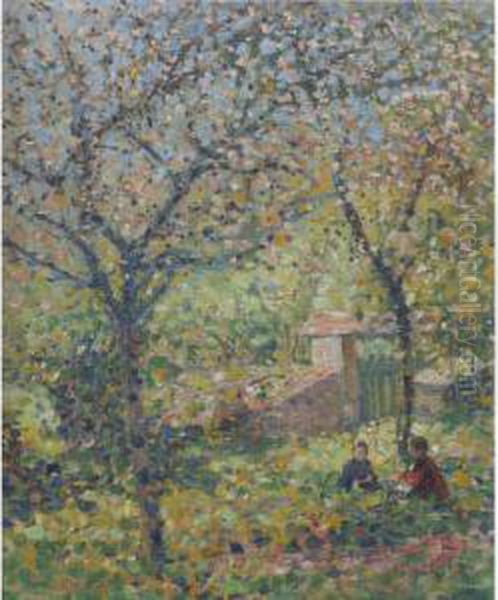
Karl Albert Buehr is best characterized as an American Impressionist. His mature style, heavily influenced by his Giverny experience, showcases the key tenets of the movement. He employed a bright, high-keyed palette, often juxtaposing complementary colors to create vibrant, luminous effects. His brushwork was typically broken and visible, allowing individual strokes to coalesce in the viewer's eye, conveying a sense of immediacy and capturing the fleeting qualities of light.
Buehr excelled in both landscape and figure painting. His landscapes often depict sun-drenched gardens, tranquil countryside scenes, and the play of light on water, clearly reflecting the plein air ethos of Giverny. He was particularly adept at rendering the dappled sunlight filtering through leaves, a favorite motif of many Impressionists.
His figure paintings frequently feature women, often elegantly dressed, engaged in leisurely activities in domestic interiors or, more commonly, in outdoor settings like porches and gardens. These works are characterized by a sense of serenity and intimacy. Buehr treated his figures with a gentle sensitivity, integrating them harmoniously with their light-filled surroundings. Unlike the more socially critical realism of some of his American contemporaries like Robert Henri or John Sloan of the Ashcan School, Buehr's focus remained on beauty, light, and the pleasant aspects of life, aligning him more closely with Impressionists like Berthe Morisot or fellow American Mary Cassatt in their depictions of women's lives, albeit often in more idyllic settings.
While his primary allegiance was to Impressionism, his work, like that of many artists whose careers spanned several decades, likely showed subtle evolutions. The provided information suggests that while he remained dedicated to color expression, his brushwork and techniques might have shifted somewhat as Impressionism's dominance waned in the face of newer modernist movements in the 1930s and 40s.
Key Works and Recognition
Throughout his career, Karl Albert Buehr produced a significant body of work and received notable recognition for his artistic achievements. Several paintings are frequently cited as representative of his style and skill:
Young Lady Crocheting (Expectancy) (1911): This work likely exemplifies his Giverny period, showcasing his ability to capture a quiet domestic moment imbued with light and delicate color. The subject, a young woman absorbed in her craft, is a common theme in Impressionist art, allowing for an exploration of interior light and texture.
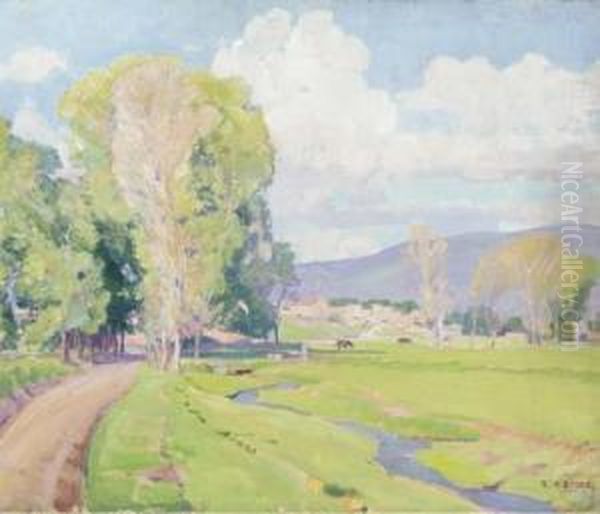
Ranchos of Taos (1930): This title suggests a later period and a shift in subject matter, possibly indicating travels to the American Southwest, which was becoming another popular destination for artists drawn to its unique light and landscape, such as Ernest L. Blumenschein and Bert Geer Phillips who were founders of the Taos Society of Artists. This work would demonstrate Buehr's application of his Impressionist techniques to a different regional character.
Daydreams: While the date is not specified, this title evokes the kind of introspective, often female, subjects favored by Impressionists, focusing on mood and atmosphere.
The Young Hostess: This painting earned Buehr the Harry A. Frank Prize in 1920, a testament to its quality and his standing in the Chicago art community.
Sunday Afternoon: For this work, Buehr received the Jule F. Brower Prize in 1925, another significant Chicago-based accolade.
Girlhood: This piece garnered the William O. Thompson Prize in 1924.
These awards, primarily from Chicago-based institutions and exhibitions, underscore his prominence within that regional art scene. Beyond these, Buehr received a Silver Medal at the prestigious St. Louis Exposition (Louisiana Purchase Exposition) in 1904, an event that brought international attention to American art and industry. He also received a silver medal from the Chicago Society of Artists in 1914.
His works found their way into various collections, including the Art Institute of Chicago and the Illinois State Building Commission. The market for his paintings has remained active, with works like Young Woman on a Porch reportedly achieving strong prices at auction, indicating a continued appreciation for his artistry. Another piece, Spring Landscape, also found success in the auction market.
Contemporaries and Artistic Milieu
Buehr's career unfolded during a dynamic period in American art. In Chicago, he was part of a group of artists sometimes referred to as the "Chicago Impressionists," which included figures like Pauline Palmer and Adam Emory Albright, who also adapted Impressionist techniques to Midwestern subjects.
His time in Giverny placed him at the epicenter of American expatriate Impressionism, alongside Frieseke, Metcalf, Robinson, Rose, and Perry. These artists, while sharing a common inspiration from French Impressionism and Monet, each developed individual nuances in their style. Frieseke, for instance, became particularly known for his nudes and figures in vibrant, decorative settings, often with a brighter, more pastel palette than some of Monet's work. Theodore Robinson's work is noted for its structural solidity underlying the Impressionist brushwork.
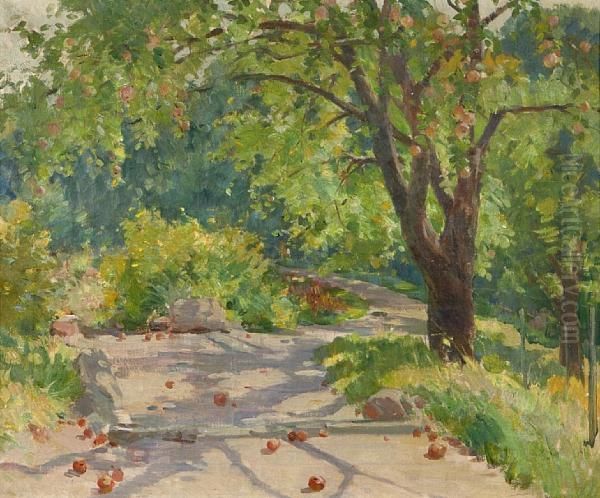
Nationally, Buehr was a contemporary of the leading figures of American Impressionism, such as Childe Hassam, whose depictions of flag-draped New York streets and New England landscapes are iconic; John Henry Twachtman, known for his subtly toned, atmospheric winter landscapes; and J. Alden Weir. While Buehr may not have achieved the same level of widespread fame as some of these East Coast-based artists, his contribution to the spread and interpretation of Impressionism, particularly in the Midwest, is undeniable.
Later Years and Evolving Style
Karl Albert Buehr continued to paint and teach for many years. He remained active through the 1930s and 1940s, a period when Impressionism was no longer the avant-garde. Modernist movements like Cubism, Surrealism, and Abstract Expressionism were taking center stage. While the provided information suggests Buehr remained committed to "color expression," it also notes that his "brush and technique changed" as the popularity of Impressionism waned. This implies a possible adaptation or evolution in his style, perhaps a subtle shift in palette, composition, or handling of paint, though he likely never fully abandoned his Impressionist roots.
Many artists of his generation faced the challenge of adapting to or resisting the dramatic shifts in the art world. Some, like Buehr, continued to refine their established styles, finding an enduring appeal in the principles that had initially inspired them. His long tenure as a teacher at the Art Institute of Chicago suggests a continued relevance and respect for his artistic vision, even as new trends emerged.
Personal Life
While much of the focus is on his artistic career, some details of Karl Albert Buehr's personal life are known. He married Mary Hess, and the couple had three children. His brother-in-law (or perhaps brother, as some sources are ambiguous, but likely Mary's brother given the surname Hess for his wife) was Will Hess, also an artist. Family archives, including letters and photographs, offer glimpses into their lives, suggesting a supportive familial environment. These personal connections undoubtedly played a role in his life and, indirectly, his work.
Legacy and Influence
Karl Albert Buehr passed away in 1952. His legacy is multifaceted. As a painter, he created a significant body of work that beautifully exemplifies American Impressionism, characterized by its joyful celebration of light, color, and the everyday beauty of the world. His paintings are valued for their technical skill, their luminous quality, and their serene, optimistic vision. He successfully translated the lessons of French Impressionism into an American context, contributing to the rich tapestry of regional artistic expression in the United States.
As an educator, Buehr had a lasting impact on generations of students at the Art Institute of Chicago. He helped to disseminate the principles of Impressionism and provided rigorous training in painting, shaping the skills and artistic outlooks of many younger artists. His students, such as William S. Schwartz and Christian von Schneidau, went on to have their own successful careers, carrying forward aspects of his influence.
His connection to Giverny and figures like Monet and Frieseke also places him within the important narrative of transatlantic artistic exchange that enriched American art in the late 19th and early 20th centuries. He was part of a pioneering group of American artists who sought training and inspiration abroad and then returned to contribute to the development of a distinct American artistic identity.
Today, Karl Albert Buehr's paintings are held in museum collections and appreciated by private collectors. His work continues to be exhibited and studied, recognized for its contribution to American Impressionism and its enduring aesthetic appeal. He remains a testament to the power of artistic dedication, the importance of mentorship, and the timeless allure of capturing light on canvas. His journey from Germany to the heartland of America, and then to the cradle of Impressionism in France, reflects a life dedicated to the pursuit of artistic excellence and the sharing of that passion with others.